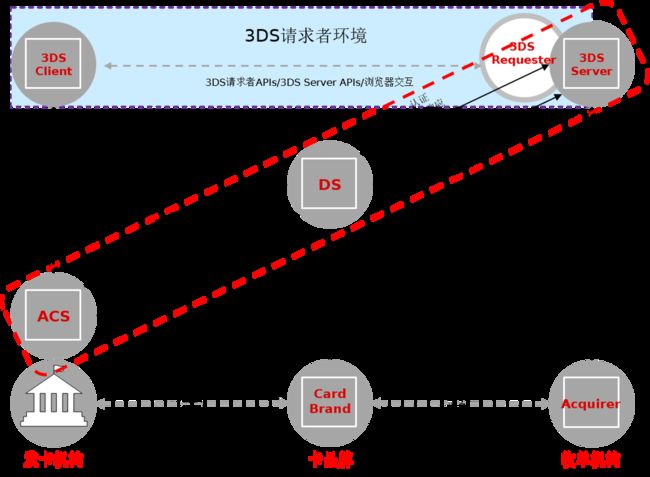PCI 3DS 技术常见问题解答(FAQ)简介
本文为atsec和作者技术共享类文章,旨在共同探讨信息安全的相关话题。转载请注明:atsec和作者名称。
1. PCI 3DS标准简介
为了降低交易欺诈风险,Visa Inc.于2001年开发并推出了3-D Secure(3DS)V1.0协议。3DS协议对无卡交易(CNP:card-not-present)电子商务购买过程启用了安全身份验证,以达到降低欺诈交易的风险。3DS的安全身份验证协议基于三域模型作为协议核心基础,3DS包含的三个域分别是发卡域、商户/收单域和交互域,详细信息如下:
- 发卡域
- 持卡人和消费者设备
- 访问控制服务器(ACS:Access Control Server)
- 发卡机构(Issuer)
- 商户/收单域
- 3DS请求者(3DS Requester)
- 3DS客户(3DS Client)
- 3DS服务器(3DS Server)
- 交互域
- 目录服务器(DS:Directory Server)
- 目录服务器证书颁发机构 (DS-CA:Directory Server Certificate Authority)
- 授权系统(Authorisation System)
其中收单域和发卡域通过交互域连接,目的是在电子商务交易期间对持卡人进行身份验证或提供身份验证和账户确认。这些额外的安全防护有助于防止未经授权的CNP交易,并保护商家免受CNP 欺诈。随着标准的不断发展和完善,当前最新的协议版本是3DS V2.3.0。目前3DS协议参与的卡品牌包括American Express、Discover、JCB、Mastercard、UnionPay和VISA。
3DS协议层面的实现由EMV®维护的文档“EMVCo_3DS_Protocol and Core Functions Specification”和“EMVCo_3DS_SDK Specification”进行定义,而实现3DS协议的应用程序所在环境的安全性则通过PCI SSC(Payment Card Industry Security Standards Council)维护的PCI 3DS核心安全标准来保护。从下图我们可以清楚的了解到PCI 3DS核心安全标准关注的3DS对象主要包括:3DS server、ACS和DS。
图1:PCI 3DS核心标准关注的EMV® 3DS对象
2. PCI SSC维护的PCI 3DS标准
PCI SSC维护了3DS协议运行环境相关的安全标准要求和报告模板,并负责授权PCI 3DS核心安全标准相关的评估机构和评估人员,以下是PCI SSC维护的与3DS相关的安全标准:
- PCI 3DS Core Security Standard—重点关注特定3DS功能及其所处环境需要注意的安全控制要求。
- PCI 3DS Data Matrix—PCI 3DS数据矩阵,该文档列举了3DS交易过程中被定义为敏感数据的数据元素列表。
- PCI 3DS SDK Security Standard—重点关注3DS SDK实施过程需要注意的安全控制要求。
PCI 3DS核心安全标准分为两个部分。第一部分是用于保护3DS数据环境(3DE:3DS Data Environment)的技术和操作安全控制的基线要求。如果机构的3DE环境已经完整实现了PCI DSS的合规评估,可以采用PCI DSS评估结果支持PCI 3DS第一部分要求的验证。
- 维护所有人员的安全策略
- 安全网络连接
- 开发和维护安全系统
- 脆弱性管理
- 管理访问
- 物理安全
- 事件响应准备
PCI 3DS要求的第二部分是3DS安全要求,用于保护3DS数据和流程。无论机构是否已经PCI DSS合规,如果机构执行3DS功能,则第二部分的要求必须作为评估的内容被执行。
- 验证范围
- 安全管控
- 保护3DS系统和应用
- 针对3DS系统的安全逻辑访问
- 保护3DS数据
- 密码和密钥管理
- 3DS系统的物理防护
3. PCI 3DS技术FAQ
根据PCI SSC的要求,机构在执行PCI SSC相关标准合规或者评估的时候,除了要满足标准本身的要求以外,还需要考虑技术常见问题解答(FAQ:Frequently Asked Questions)的内容。技术FAQ是PCI SSC所维护标准不可或缺的强制性部分,在PCI SSC相关标准安全评估过程中必须予以考虑。技术FAQ可能包含有关如何解释需求的信息,在某些情况下,还可能添加新的或扩展现有的需求。对于PCI 3DS评估,机构除了需要符合PCI 3DS核心安全标准的要求,还需要考虑PCI 3DS 技术FAQ“3DS Core v1.x Technical FAQs”的内容。
3.1 PCI 3DS技术FAQ包含的内容
PCI SSC于2023年9月27日对PCI 3DS技术FAQ进行修订,当前最新版本的PCI 3DS技术FAQ包含了对如下问题的解答:
问题1: 如果身份验证值(AV)是加密生成的值(例如“密码”),是否需要根据PCI 3DS核心要求P2-5.4.2对其进行加密?(2021年4月发布)
回复:加密生成的身份验证值(AV)是否可以在不加密(再次加密)的情况下存储将取决于每个支付系统(即支付品牌)如何生成AV以及如何使用该值。
“EMVCo_3DS_Protocol and Core Functions Specification”并没有规定生成AV所需的方法或算法,并使每个支付系统能够确定使用哪种方法和/或算法。PCI 3DS核心安全标准假设这些值是在3DS传输处理过程中直接使用的静态值,因此,在任何允许存储之前,必须根据PCI 3DS数据矩阵和PCI 3DS核心安全标准要求P2-5.4.2与其他3DS敏感数据一起进行加密存储。
如果AV是一个动态值(比如是一次性的值)在生成后不能重复使用,或者已经使用强加密算法进行了加密,并且需要在使用前对该值进行解密,则可以在允许的情况下存储该AV且无需再次加密。3DS实体应联系相关的卡品牌,以获取有关该支付系统生成和使用的AV是否可以不需额外加密而进行存储的更多信息。
问题2:哪种3DS组件要求使用硬件安全模块(HSM:hardware security module)保护和管理加密密钥?(2021年4月发布)
回复:要求P2-6涵盖所有3DS组件(包括ACS、DS和3DS服务器)的加密和密钥管理。P2-6.1.2明确指出,只有包含DS和/或ACS系统的环境才需要使用FIPS 140-2的3级(整体合规)或更高级别认证,或PCI PTS批准的HSM进行所有密钥管理活动。其他HSM相关要求,如要求P2-6.2和P2-6.3,仅适用于ACS和DS所在的环境。
对于只有3DS服务器的环境,建议但不强制使用HSM进行加密和密钥管理。
问题3:是否可以使用补偿控制措施满足P2-6.2.1的要求?(2023年9月发布)
回复:不可以。要求 P2-6.2.1 要求具有 HSM 逻辑访问权限的人员使用 HSM 控制台或使用非控制台访问解决方案来访问这些 HSM。
然而,自2023年9月版本的技术FAQ发布生效后,不再专门要求非控制台 HSM 访问解决方案由独立实验室进行评估以验证是否符合 ISO 13491。
非控制台 HSM 访问解决方案的另一组要求如下。请注意,如果完全满足以下这些要求,则可用于满足当前发布的要求 P2-6.2.1 至 P2-6.2.5。如果使用这些替代要求,请在合规报告(ROC: Report On Compliance)中针对每个相应要求记下此技术FAQ,并包含适当的评估和文档以验证所规定的要求是否已得到满足。
- (P2-6.2.1) Non-console HSM access for the purposes of management and configuration requires the use of MFA.
- (P2-6.2.2) Non-console HSM access for the purposes of management and configuration is performed using a secure channel.
- (P2-6.2.3) Secret or private cryptographic keys, key components, and/or key shares input to or output from the HSM are secured through dual control and split knowledge.
- (P2-6.2.4) Non-console access used for the loading of clear-text key components or key shares originates from a Secure Cryptographic Device (SCD), that is either:
- Listed on the NIST Cryptographic Module Validation Program (CMVP) list and approved to FIPS 140-2 Level 3 or 140-3 Level 3 (overall) or higher. Refer to http://csrc.nist.gov.
或者,
- Listed on the PCI SSC website, with a valid PCI SSC listing number, as an Approved PCI PTS Device.
- Listed on the NIST Cryptographic Module Validation Program (CMVP) list and approved to FIPS 140-2 Level 3 or 140-3 Level 3 (overall) or higher. Refer to http://csrc.nist.gov.
- (P2-6.2.5) When loaded through a non-console interface, key components and key shares are encrypted using a key encryption key that is specific for the purposes of key transport. Use of encryption provided by a secure channel is not sufficient to meet this requirement.
问题4:3DS实体是否可以将其HSM的托管和管理外包给第三方服务提供商?(2020年12月发布)
回复:可以。只要满足所有适用要求,3DS实体可以选择将其HSM基础设施的托管和管理外包给第三方服务提供商。3DS实体应与其服务提供商合作,以确定哪些要求由服务提供商负责合规,哪些要求由3DS实体负责合规。3DS实体仍然最终负责确保满足有关HSM托管和管理的所有适用要求。相关更多信息,请参阅PCI 3DS核心安全标准中的“使用第三方服务提供商/外包”章节的内容。
问题5:哪些类型的3DS组件在PCI 3DS核心安全标准要求P2-7的范围内?(2020年12月发布)
回复:与数据中心和闭路电视(CCTV:closed circuit television)安全相关的要求P2-7.1和P2-7.2仅适用于DS和ACS系统。
如要求P2-7概述部分所述,DS和ACS系统是3DS基础设施的关键组件,需要具有更高物理安全控制的安全设施来限制、管理和监控所有物理访问。
对于仅存在 3DS 服务器的位置,建议满足 P2-7 中的要求,但不是必需的。有关不同 3DS 组件的信息,请参阅 PCI 3DS 核心安全标准。
3.2 PCI 3DS新增技术FAQ分析
PCI SSC于2023年9月27日对PCI 3DS技术FAQ的更新,新增了对“是否可以使用补偿控制措施满足P2-6.2.1的要求?”问题的回复。PCI SSC为3DS实体安全管理HSM提供额外可选的合规思路。以下是原始合规要求和可选合规要求的对比:
| 原始合规要求 |
可选合规要求 |
| 6.2.1 Personnel with logical access to HSMs must be either at the HSM console or using an HSM non-console access solution that has been evaluated by an independent laboratory to comply with the following sections of the current version of ISO 13491:
|
(P2-6.2.1) Non-console HSM access for the purposes of management and configuration requires the use of MFA. |
| 6.2.2 All non-console access to HSMs originates from a 3DE network(s). |
(P2-6.2.2) Non-console HSM access for the purposes of management and configuration is performed using a secure channel. |
| 6.2.3 Devices used to provide personnel with non-console access to HSMs are secured as follows:
|
(P2-6.2.3) Secret or private cryptographic keys, key components, and/or key shares input to or output from the HSM are secured through dual control and split knowledge. |
| 6.2.4 The loading and exporting of clear-text cryptographic keys, key components, and/or key shares to/from the HSM is not permitted over a non-console connection. |
(P2-6.2.4) Non-console access used for the loading of clear-text key components or key shares originates from a Secure Cryptographic Device (SCD), that is either:
or,
|
| 6.2.5 Activities performed via non-console access adhere to all other HSM and key-management requirements. |
(P2-6.2.5) When loaded through a non-console interface, key components and key shares are encrypted using a key encryption key that is specific for the purposes of key transport. Use of encryption provided by a secure channel is not sufficient to meet this requirement. |
原始的PCI 3DS核心安全要求允许3DS实体采用本地控制台和远程非控制台方式对HSM进行管理。但如果3DS实体采用远程非控制台的形式对HSM进行管理,则HSM的非控制台需要经过由独立的实验室根据ISO 13491标准进行评估。随着云环境的日益普及,对HSM的远程管理变得越来越重要。但对HSM非控制台执行额外的ISO 13491评估会极大的增加3DS实体合规的时间和经济成本。因此PCI SSC此时推出备选的HSM管理要求显得尤为重要。备选的HSM管理要求从如何加强认证操作人员身份(采用多因素认证方式)、采用安全通道、双人操作和知识分离方式、经过安全认证的安全加密设备(SCD:Secure Cryptographic Device)对密钥进行操作等方面入手确保实现对HSM的安全管理,做到了在不降低安全要求级别的前提下,极大的减少对3DS实体对HSM的操作限制,有效的提供了3DS实体的操作效率。
4. 结束语
随着新技术的不断出现,PCI SSC维护的标准也在不断的演进和完善。atsec作为PCI SSC授权的PCI 3DS评估机构和全球执行评估机构圆桌会议(GEAR: Global Executive Assessor Roundtable)的成员机构之一,从2018年起持续多年积极参与GEAR工作并贡献于产业发展,进一步致力于全球支付卡数据的安全保障。atsec作为战略性合作伙伴,圆桌会议的成员机构将代表评估机构产业,为PCI SSC的计划和项目从产业、地域和技术领域提出见解。期待更多的机构参与到PCI SSC的参与机构,为标准和产业发展提供宝贵的意见和建议。
5. 参考文档和链接
- Payment Card Industry 3-D Secure (PCI 3DS) Security Requirements and Assessment Procedures for EMV® 3-D Secure Core Components: ACS, DS, and 3DS Server Technical FAQs for use with Version 1.x September 2023: https://docs-prv.pcisecuritystandards.org/3DS/Frequently%20Asked%20Questions%20(FAQ)/PCI_3DS_Core_v1.x_Technical_FAQs_Sep2023.pdf
- PCI 3DS Core Security Standard: https://www.pcisecuritystandards.org/documents/PCI-3DS-Core-Security-Standard-v1.pdf
- Payment Card Industry 3-D Secure (PCI 3DS) Security Requirements and Assessment Procedures for EMV® 3-D Secure Core Components: ACS, DS, and 3DS Server Technical FAQs for use with Version 1.x: https://docs-prv.pcisecuritystandards.org/3DS/Frequently%20Asked%20Questions%20(FAQ)/PCI_3DS_Core_v1.x_Technical_FAQs_Sep2023.pdf
- atsec: www.atsec.cn
